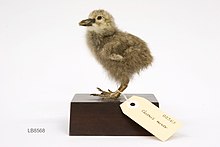Black-faced sheathbill
| Black-faced sheathbill | |
|---|---|

| |
| Scientific classification | |
| Domain: | Eukaryota |
| Kingdom: | Animalia |
| Phylum: | Chordata |
| Class: | Aves |
| Order: | Charadriiformes |
| Family: | Chionidae |
| Genus: | Chionis |
| Species: | C. minor
|
| Binomial name | |
| Chionis minor Hartlaub, 1841
| |

The black-faced sheathbill (Chionis minor), also known as the lesser sheathbill or paddy bird, is one of only two species of
Description
They are dumpy, short-necked, pigeon-like birds with white plumage, black bills, caruncles and facial skin. This species measures 38–41 cm (15–16 in) in length, 74–79 cm (29–31 in) in wingspan and weighs 460–730 g (1.01–1.61 lb), with males being slightly larger than females.[2]
Distribution
Restricted to subantarctic islands in the southern Indian Ocean: the South African territory of the Prince Edward Islands, the French territories of the Crozet Islands and Kerguelen Islands, and the Australian territory of Heard Island. The race C. m. nasicornis is endemic to Heard Island, while the race C. m. marionesis is endemic to the Prince Edward Islands.
Habitat
Coastlines and intertidal zones of subantarctic islands, especially around seabird and seal colonies, as well as the vicinity of human habitation.
Food
Sheathbills are opportunistic
Voice
Loud, high-pitched, strident and staccato calls.
Breeding

Nests in crevices, caves and under boulders on untidy piles of vegetation and debris from seabird and seal colonies. Clutch usually 2–3 creamy-white eggs, blotched or speckled brown. Incubation period c.30 days. Young semi-precocial and nidicolous; fledging c.50 days after hatching; breeding at 3–5 years.
Conservation
At risk from scavenging
References
- . Retrieved 12 November 2021.
- ISBN 978-0-8493-4258-5.
- BirdLife International. (2006). Species factsheet: Chionis minor. Downloaded from https://web.archive.org/web/20210828092113/https://www.birdlife.org/ on 11 February 2007
- Marchant, S.; Higgins, P.J.; & Davies, J.N. (eds). (1994). Handbook of Australian, New Zealand and Antarctic Birds. Volume 2: Raptors to Lapwings. Oxford University Press: Melbourne. ISBN 0-19-553069-1
- ISBN 0-207-15348-5

